Damien Hirst, Toddler's Cloud, 2016. 20th Century to Now, London.
Under the Ruwenzori Foundation in Uganda, Damien Hirst has been privately funding for several years the construction of a 40-bed cottage hospital located in the remote village of Kyemihoko. Through his extensive donations, the Damien Hirst Hospital is now close to completion and poised to provide vital medical care and support to the community. With a comprehensive range of facilities, including an accident and emergency unit, operating theater, x-ray scanning capabilities, a pharmacy, treatment rooms, and dedicated pediatric wards, the hospital is committed to addressing the pressing healthcare needs of the region.
In an exciting development that underscores the spirit of giving, three artworks by Damien Hirst — Toddler's Cloud (2016), Eshara (2019), and Decahydronaphthalene (2019) — will be featured in the upcoming auction, 20th Century to Now, at Phillips in June. The artist will dedicate the entirety of his proceeds from the sale of these works to the Damien Hirst Hospital, enabling it to further advance and expand much-needed healthcare initiatives. This significant infusion of funds will have a lasting impact on the health of those in the region, allowing the hospital to provide enhanced services, acquire essential medical equipment, and support ongoing healthcare programs that would otherwise be impossible.
Of his relationship with the Ruwenzori Foundation and the hospital, Damien Hirst has said, “I have supported many charities over the years but now, with the help of the Ruwenzori Foundation, I have decided to put most of my charitable efforts into a single large-scale project. This will be a significant milestone in healthcare provision in Western Uganda, aiming to uplift and transform the well-being of the local community. Through its extensive range of services, the hospital will ensure that residents have access to critical medical care when they need it most.”

Damien Hirst, Decahydronaphthalene, 2019. 20th Century to Now, London.
Featuring some of British artist Damien Hirst’s most iconic motifs including spots, dots, and butterflies, the three works presented here showcase the enduring power of the artist’s vision, and the close conceptual connections that have structured his oeuvre from his very earliest beginnings.
Meticulously rendered, Hirst’s Spot Paintings are undoubtably amongst the artist’s most prized and immediately recognizable works. Striking a balance between the languages of art and science, the Spot Paintings and the subset of Pharmacological Paintings form an important cornerstone of the artist’s practice, dating back to his earliest beginnings as a student at Goldsmiths, University of London and the infamous 1988 Freeze exhibition.

Damien Hirst, Eshara, 2019. 20th Century to Now, London.
Similarly, butterflies have long fascinated Hirst, their delicate beauty and short life cycles lending themselves to more philosophical mediations on the transience of life, and our relationship to the divine. For his first solo show In and Out of Love, Hirst transformed the ground floor of the disused commercial space into a humid hothouse, the walls hung with pupae covered canvases, which hatched over the duration of the show. Echoing the fascination for structure and visual order evident in a Spot Painting like Decahydronaphthalene and across his three-dimensional cabinet works, Eshara borrows the tondo format of Gothic Rose windows and the mandala in an absorbing and meditative concentric arrangement of iridescent butterfly wings.
Eschewing the systems of visual order carefully maintained in his spots and kaleidoscopic butterfly works, Toddler’s Cloud represents a joyful embrace of the possibilities of color that underlined his earliest Spot Paintings, the tightly packed and more loosely rendered dots of brightly colored enamel seemingly at odds with the careful chromatic control and mathematical precision of the more minimal Decahydronaphthalene. Taken togeher, these three works outline some of the central themes that continue to preoccupy the artist — those of color, system, structure and the porous boundaries between art, science, belief, and beauty — emphasizing too Hirst’s endlessly inventive approach, even within the restricted criteria set by any individual series.
Discover More from 20th Century to Now >
Recommended Reading
